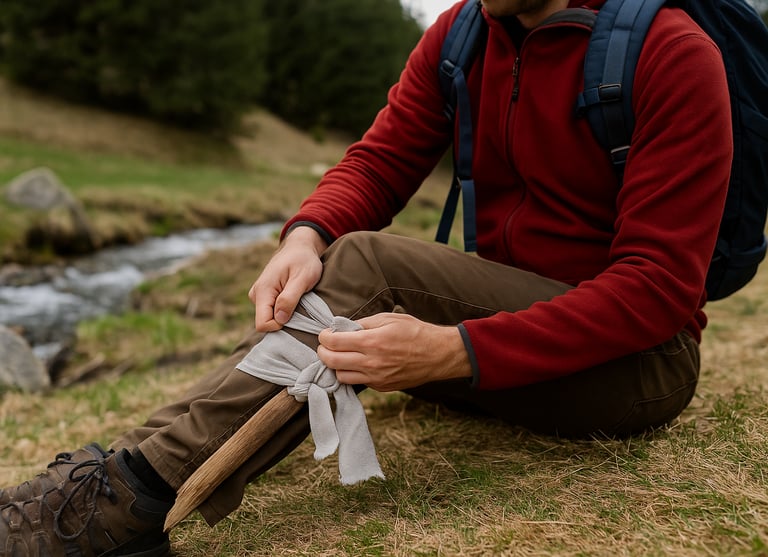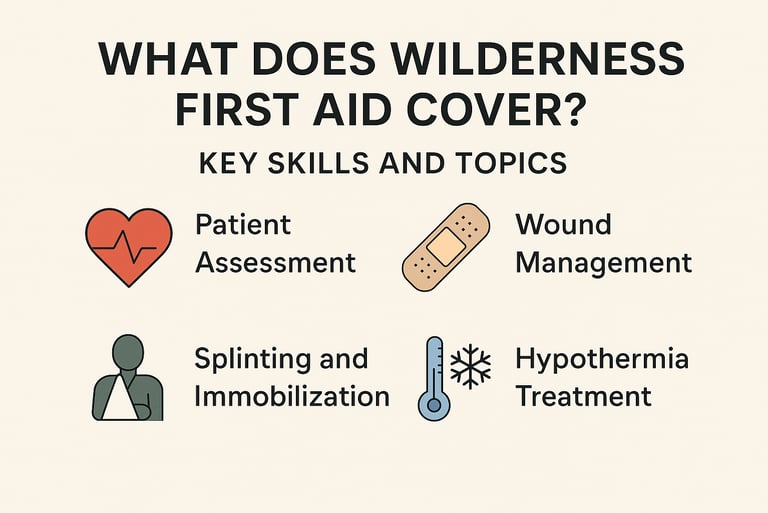Wilderness First Aid: Key Skills and What It Actually Covers
Discover what wilderness first aid actually covers. Learn the essential survival skills, emergency care techniques, and environmental first aid topics included in this life-saving training for outdoor enthusiasts.


Wilderness First Aid: Key Skills and What It Actually Covers
What Wilderness First Aid Is Really About
Wilderness first aid isn’t just a longer version of a basic first aid course. It’s a hands-on training designed for people who spend time in remote areas, where calling 911 isn’t an option and help could be hours—or even days—away. Whether you're a hiker, camper, or outdoor guide, this kind of training prepares you to manage emergencies when you're completely on your own.
The core goal of wilderness first aid is self-reliance. It focuses on skills you can use in environments where weather, terrain, and distance make traditional emergency response impractical. If you’ve ever asked, “What does wilderness first aid cover?” — the answer is a lot more than just bandages and CPR.
Assessment and Stabilization in Remote Areas
One of the first things you’ll learn is how to assess a patient using a primary and secondary survey in challenging outdoor conditions. This includes checking for life-threatening injuries, monitoring breathing and circulation, and identifying underlying issues that may not be obvious at first.
You’ll also learn how to stabilize injuries with limited resources. That might mean using trekking poles to splint a broken limb or crafting a makeshift stretcher from a tarp and rope. The focus is on making smart decisions with whatever you have on hand, because time and gear are limited in the backcountry.
When you're building makeshift splints or trying to immobilize a fracture far from help, it’s essential to know how to use the tools around you. For example, learning how to make a wilderness splint or sling using natural materials can give you the confidence to handle sprains, breaks, or dislocations using sticks, bandanas, or even parts of your clothing.
Environmental Emergencies and Long-Term Care
Wilderness first aid training also covers environmental emergencies that are common in the wild. You’ll learn how to recognize and treat hypothermia, heat exhaustion, heat stroke, dehydration, and altitude sickness. These aren’t conditions you typically see in standard urban first aid — but in the wild, they’re often life-threatening.
Since evacuation may not be quick or even possible right away, wilderness courses also emphasize long-term care and patient monitoring. This includes keeping someone warm, hydrated, and comfortable while waiting for help or navigating a self-rescue. You'll also learn how to clean and manage wounds to prevent infection, which becomes crucial the farther you are from a hospital.
Improvisation and Decision-Making in the Field
One of the most important skills wilderness first aid teaches is how to adapt. You won’t always have a first aid kit handy, so you’ll learn to use natural materials and the contents of your backpack to treat injuries. Knowing how to think creatively under pressure is what separates wilderness care from standard first aid.
Equally important is scene management and decision-making. Wilderness training helps you determine when to stay put versus when to evacuate, how to prioritize multiple injuries, and how to maintain calm and leadership under stress. These mental and emotional skills are just as important as the physical treatments.
Wilderness emergencies rarely go by the book. Whether you’re responding to a fall, a burn, or a sudden illness, understanding common wilderness injuries and how to treat them will help you stay calm and prioritize effectively under pressure. It’s also smart to pack and maintain a well-rounded wilderness survival kit, not just with medical supplies but with tools that can help you signal for help, stay warm, or create shelter while waiting for rescue.
Is Wilderness First Aid Worth Learning?
If you spend any time in nature beyond the reach of quick emergency response, wilderness first aid is one of the most valuable things you can learn. It’s not just about treating injuries — it’s about staying calm, resourceful, and effective in the moments that matter most.
From basic assessments to life-saving interventions, these courses cover everything you need to be a reliable responder when it counts. Whether you're deep in the backcountry or just a few miles from the nearest trailhead, this knowledge can bridge the critical gap until help arrives.


© 2025. All rights reserved About | Privacy Policy | Terms and Conditions | Affiliate Disclosure | Disclaimer


